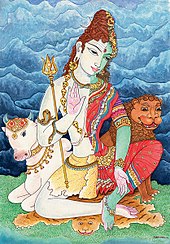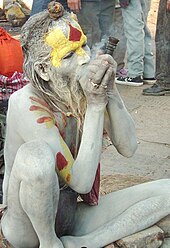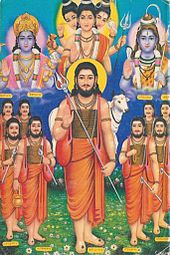Shaivism
For Shaivism or Shaivism (from Sanskrit शैव Śaiva [ ʃaiʋʌ ] "Shiva duly") are among those directions of Hinduism , in which Shiva the central role as the supreme deity , which puts Supreme Being, of all other gods dominates and this way the whole universe can emerge. Shaivism is a form of religion in which God is thought of as immanent and transcendent at the same time .
In religious practice and philosophical teachings, Shaivism is not a uniform form of religion. Differences in episch- be puranische Shivaism, the Vedic is aligned -brahmanisch and popular religious, and esoteric -sektarische Shivaism that requires initiation and in the Brahmins are in the minority.
So the mythical Shiva of the Puranas does not play a role in sects of esoteric Shivaism, but Shiva appears here as transcendent and, as with the Kashmiri Shaivas, also as monistic , whereby the goal of this religion is liberation (redemption) and sometimes the acquisition of Siddhis . In contrast, z. B. in the Tamil Shaiva-Siddhanta Shiva seen as a personal deity, and Moksha as an identification with the personal god.
In addition to the cultic Shaivism, there is also a devotional and poetic Shaivism, which developed in succession to certain mystics, such as B. the movement of the Lingayats or Vira Shaivas.
The Dashanami Sampradaya (see Hindu Order ), which was founded by Shankara in the 8th century AD , is also counted among the Shaivas by many, and some subgroups can clearly be assigned to the Shaivas. Similar to Kashmiri Shaivism, the philosophical orientation of these groups is mainly monistic . The main script of the Juna Akhada, the Avadhuta Gita , is a radically monistic work.
While Vishnuism is mainly oriented towards the loving bond between man and God (see Bhakti ), some directions of Shaivism attach great importance to the possibility of man to become one with God . Some directions see salvation in reaching a Shiva-like state and in continuous contact with it. Most Shivaite groups accept a philosophical-theological system as valid that knows three eternal principles: Pati, the Lord (Shiva), Pashu, the cattle (the individual soul ) and Pasha, the fetter (matter and karma ). In order to come into contact with Shiva, Atman (cf. soul) must free himself from the bonds of karma and matter and become similar to the state of Shiva, i.e. H. reach up to his power and his knowledge and have escaped the possibility of suffering.

There are many different Shivaite groups, and many of them practice teachings of yoga and tantra . Strict antinomistic asceticism is also common, e.g. B. among the Kalamukhas and Kapalikas . The movement of the ascetic natha yogis, the origin of which is unclear, seems to contain elements of Buddhism . The goal of the Natha yogis is to achieve the state of Sahaja Samadhi , in which the yogi is one with the universe in complete rest and at the same time is Shiva, Shakti , teacher, student, meditation , object of meditation and meditator.
Shaivism includes differentiated cultic acts as well as complex philosophical - theological systems (cf. Samkhya ), which can only be presented here in a simplified manner. A Shivaite literature developed, which includes twenty-eight orthodox agamas and about two hundred additional texts. The Puranas are an essential source of text . Esoteric Shaivism refers to the agamas and tantras .
Shaivism has millions of followers and thousands of temples and monasteries in India . Along with Shaktism and Vishnuism, it is one of the three main directions of Hinduism, and there is also the Indian folk religion . It is particularly popular today in southern India and Kashmir .
history
The early Shaivism based its theology on that of the Vishnuits . Its early forms emerged under the priests of Yajurveda . From the 4th century onwards it developed into an independent direction. The heyday of Shaivism began in the 9th century and from the 10th century existing temple complexes were established in southern and central India. From the 10th century onwards, the main schools of Shaivism are Kashmiri Shaivaism, Shaiva Siddhanta, the Natha Yogis and the Virashaivas. The heyday of Shaivism lasted until the 13th century.
The mythological Shiva of the Puranas
In the Shivaite cults, Shiva is the highest being, who surpasses all other gods in power and also created them. The beings and the world are subject to change, only Shiva alone is imperishable, eternal and the fullness of the absolute . He is the source of existence. He has various names that testify to his greatness such as Mahadeva (the Great God), Ishvara (the Lord), Maheshvara (the Great Lord), Prameshvara (the Supreme Lord). Despite his function as absolute existence and universal god, the myths always show him as a terrible god and great ascetic who indulges in terrible mortifications and is connected to nature. He is the mind ( Purusha ), the essence of the entire manifested world ( Prakriti ) and the driving force of this world. It is reserved for him alone to let the world arise and pass away. After the end of the world, which he periodically brought about, nothing remains except Shiva himself, and he cyclically creates new universes through the Maya of his yoga , from which the lotus arises, from which Brahma emerges. The entire universe is thought of as arising from the dance of Shiva Nataraja and disappearing in it. His dance sustains the world and redeems souls. He performs his dance surrounded by gods in the Himalayas , as a ten-armed being surrounded by demons and devi on morgues and in the golden halls of the Nataraja temple of Chidambaram, the center of the universe. His dance symbolizes his fivefold qualities of evolution : receiving, contracting, concealing (of the souls in samsara ), the gracious acceptance of believers and the giving of peace and redemption . As an absolute it contains the paradoxes of untamed, wild and cruel nature and the highest wisdom and deepest peace. In many representations the god is worshiped as half female, half male as Ardhanarishvara , who is one with his Shakti , his female side.
Kashmiri Shaivism
In Kashmiri Shaivism it is assumed that the teaching of the agamas is a manifestation of Shiva, the supreme deity in the form of transcendent words, and that the universe is the essence of these words, which are the thoughts of the All-God. The highest reality is accepted here as pure knowing consciousness that underlies the universe as self and inner being. She is Shiva and Atman , indescribable, eternal, infinite, transcendent and immanent, neither personal nor neuter. Every existence is an aspect of this immanent and kinetic Shiva, which manifests itself in the being as the primal force, Shakti . The separation of the knower and the known is brought about by a vibration. In this system the soul is one with the All-God, but does not recognize this as long as it is impure through the influence of the Maya, so that the goal is to lift this veil of ignorance in order to recognize the unity with the highest Atman. This requires an insight into the true nature of things in order to realize a comprehensive, objectless state of the pure self .
Shaiva Siddhanta
In southern India the Shaiva Siddhanta ( सिद्धान्त siddhānta ) developed in the 8th to 13th centuries. Siddhanta means u. a. ultimate goal, ultimate goal. The sacred literature of this direction consists of eleven collections of poems, the Tirumurai , edited in the 10th or 11th century , which deals with Shiva- Bhakti , and the Periyapuranam, in which the life of Shivaite saints is described. The texts are taught to children and sung at home, in temples and during processions . Shaiva-Siddhanta rejects monism and assumes an eternal existence of souls ( Purusha ) and the world ( Prakriti ) next to God. This is essentially based on the ideas of the dualistic Samkhya philosophy.
In contrast to Shankara's Advaita Vedanta , Shiva and the world are not identical here, but neither do they exist independently of one another. The cause of the world is the Maya , the power substance through which the world and everything unspiritual are evoked and this existence is called Mayeya, which Shiva created from the Maya and in which he works through his Shakti. The souls were brought into the world according to Shaiva Siddhanta to enable them to get rid of the impurities that were attached to them. This differs from other schools that assume that the universe is Shiva Nataraja's dance, that is, his pleasure. The five functions of Shiva are evolution, maintenance, involution, compassionate condemnation to samsara and purification and assimilation of souls. That the souls experience themselves as limited is caused by anavamala, infatuation and spiritual darkness, which cause the karma that binds the soul to existence.
Shiva is Sat, Cit, Ananda, absolute existence, limitless and omnipresent knowledge, or cosmic intelligence and perfect bliss , or absolute harmony. Shiva acts in the world through her feminine energy, the Shakti. The purification of the soul, which is necessary in order to overcome karma and eliminate the anavamala in order to reach the pure Shuddha state, consists of three stages:
- the pious walk in which the soul performs a worship service, by winding garlands of flowers for the god, praise, lighting lights, cleaning the temple, and the like. Ä.
- Cult acts such as the worship of and immersion in an image of God and the offering of burnt offerings and
- Yoga, d. H. Concentration , self-conquest and meditation with the goal of enlightenment
This means here that Shiva sends his Shakti as Arul-Shakti ("enlightenment-conferring Shakti") and the adept recognizes Shiva as transcendent and immanent and surrenders himself to him in such a way that his own individuality and activity are renounced and so the karma is dissolved becomes. It is stressed, however, that this requires a guru , a fully enlightened teacher.
Apart from the meditation, yoga and tantra practice of the Shivaitic yogis, the general Shivaism described in the Puranas consists of devotion , prayer , mantra recitation , holding ceremonies and rituals in temples and on mountains inhabited by Shiva such as Kailash and the offering of gifts such as flowers , Incense, robes, umbrellas and the like.
Natha yogis
Natha Yoga (from Sanskrit नाथ Nātha "Master, Lord, Godhead") is an Indian yoga teaching that goes back to Gorakhnath . Natha yogis are ascetic Shivaites and the goal of this yoga discipline is to achieve the highest reality, the identity with Shiva . The movement of the Natha yogis started in Bengal and later spread to the south and west. Natha yogis practice hatha yoga and try to purify the body through yoga and training of willpower and ultimately to become immortal. Also alchemy was widespread among the Natha-yogis. In this school, siddhas and eminent teachers are considered deities.
Natha Yoga is intended to purify the body and thereby achieve Jivanmukti (liberation in life). The defilements are seen as the cause of death and the practice of kaya sadhana ( physical culture) is supposed to help defeat death.
The body is seen as an image of the cosmos and the goal is to concentrate all the energy of the Shakti at the end of the spine, to guide it through the Sushumna and the chakras and to unite Shakti with Shiva in the uppermost chakra.
Natha Yoga is also practiced by means of sacred syllables ( Bija Mantra ) that exist for each chakra, which should lead to the yogi being attuned to divine vibrations (Shabda), whereupon the mantra returns to its unmanifested origin and through the whole beings vibrate.
Natha yoga is abundant in literature, and many Hatha yoga texts and late yoga Upanishads are related to it. Some texts by Nathen are accepted as the most famous texts for yogic internships in the world. Among them Hathapradipika , Gherandasamhita , Shivasamhita , Gorakshashataka .
Virashaivas
The Virashaivas, which emerged from the 12th century, form a direction of Shaivism that has broken away from Brahmanic ritualism and also rejects any form of box. There is also equal rights for men and women. Under the rulers of Mysore, Virashaivism became the state religion from 1350 to 1610. The Virashaivas carry a capsule with a Shiva Linga with them, which is why they are also called Lingayats.
In this religion Shankara and the monistic teaching of the Upanishads are formative, but this is related to Shiva as the highest being (Shiva as Brahman himself). Monism means that Shiva represents the only being, also in relation to creation and souls. Shiva Brahman is endowed with the attributes Sat, Chid, Ananda, Being, Consciousness, Bliss.
Shakti is seen as Shiva's power, and the movement of this power creates a dualism in Shiva, between Shiva and creation, which consists of the world and souls. These two are called Lingasthala (Shiva) and Angasthala (creation). Shiva here consists of three levels, the pure, non-dual being, a manifestation that can only be perceived by the mind and is subtle, and the physical linga that is worn on the body. As in most tantric schools, existence consists of 36 tattvas (categories, elements) and liberation ( jivanmukti ) means the realization of identity with Shiva, which leads to blissful union with him.
The Virashaivas practice Shiva- Bhakti and Yoga , and gurus are particularly important, as are ahimsa , vegetarianism and forms of abstinence . It is believed that a fairer and more devout way of life leads to unity with Shiva in death. The mantra 'Om Namah Shivai' is of particular importance .
Basava, who lived in the 12th century, was assumed to be the founder of the school, but recent research suggests that the Virashaiva school could have existed as early as the 10th century, since a Shivaitic yoga school is mentioned in the writings of Rajasekhara, which strongly resembles today's virashivaism and these yogis also wear a linga. Basava could therefore also have been a reformer and not the founder of the school.
See also
literature
- Axel Michaels : Hinduism . CH Beck, Munich 2006, ISBN 3-406-54974-8 .
- Heinrich von Stietencron: The Hinduism . CH Beck, Munich 2001, ISBN 3-406-44758-9 .
- Jan Gonda : The Religions of India; 2. Younger Hinduism. In: The Religions of Humanity Vol. 12. ed. by Christel Matthias Schröder ; Kohlhammer, Stuttgart [a. a.] 1963
- Jyotishman Dam: Shiva Yoga. India's great yogi Gorakshanatha . Eugen Diederichs Verlag, Munich 1998, ISBN 3-424-01393-5 .
- Jörg Gengnagel: Māyā, Puruṣa and Śiva: the dualistic tradition of Śivaism according to Aghoraśivācāryas Tattvaprakāśavṛtti. Harrassowitz, Wiesbaden 1996, ISBN 3-447-03832-2 .
- NR Bhatt: Shaivism in the light of epics, Purāṇas, and Āgamas. Varanasi, Indica Books, 2008
- V. Kameswari: Śaiva rituals and philosophy. 1st ed. Chennai, Kuppuswami Sastri Research Institute, 2001
- Lakshmi Nidhi Sharma: Kashmir Saivism. 3rd edition, Bharatiya Vidya Prakashan, Delhi 2006
- Wolf-Dieter Storl: Shiva. The wild, kind God. Koha, Burgrain 2002, ISBN 3-929512-90-4
- Namita Gokhale: The Book of Shiva. Viking, Penguin Books India 2001
Web links
- Aspects of Abhinavagupta's Theory of Revelation by David Peter Lawrence
- Lord Siva and his Worship by Sri Swami Sivananda
- Shaiva Siddhanta
- The Tradition of the Natha Yogis
- Virashaivism





